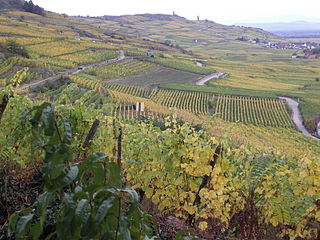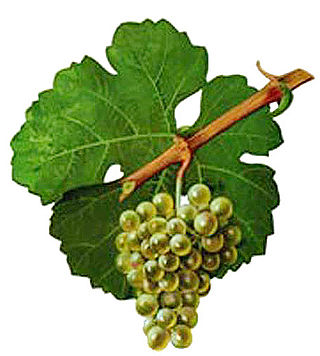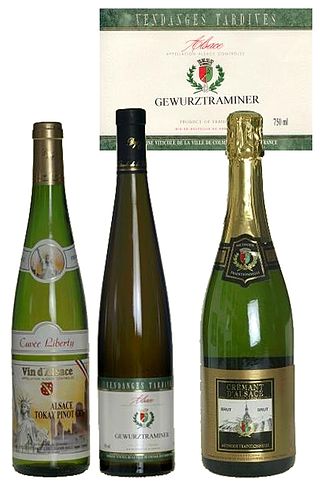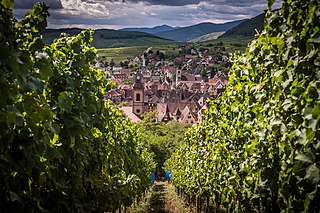
Jean "Johnny" Frederic Hugel ( September 28, 1924 - June 9, 2009) was an Alsatian wine producer, described by wine expert Tom Stevenson as "the single most important person in the development of Alsace wine industry throughout the 20th century." [1]

Jean "Johnny" Frederic Hugel ( September 28, 1924 - June 9, 2009) was an Alsatian wine producer, described by wine expert Tom Stevenson as "the single most important person in the development of Alsace wine industry throughout the 20th century." [1]
Born in the village of Riquewihr, Jean Hugel began studying winemaking after World War II, attending the University of Bordeaux and University of Montpellier from the later of which he earned a master's degree in Agronomy. In 1948 he returned to the family estate in Alsace, Hugel & Fils, where he shared in management operations with his brothers André and Georges. In 1997, Hugel scaled back on his activities in the day-to-day management of the estate as his nephews took on more prominent role. [1] He died of cancer in 2009. [2]

Jean Hugel was very active in the drafting of the Appellation d'origine contrôlée guidelines for the Alsace AOC and Alsace Grand Cru AOCs. As founder and president of the Alsace Grand Cru commission, Hugel was a major influence in defining the boundaries the Alsace Grand Cru vineyards. Hugel also developed the guidelines for the late harvest dessert wines Vendanges Tardives and Sélections de Grains Nobles. [3] When these laws were officially recognized in 1984 they were among the strictest AOC requirements in the French wine industry. [1]
Over his more than 60 years in the Alsatian wine industry, Jean Hugel won numerous awards and honors. These include: [3]

Burgundy wine is made in the Burgundy region of eastern France, in the valleys and slopes west of the Saône, a tributary of the Rhône. The most famous wines produced here, and those commonly referred to as "Burgundies", are dry red wines made from pinot noir grapes and white wines made from chardonnay grapes.

Alsace wine or Alsatian wine is produced in the Alsace region in France and is primarily white wine. Because of its Germanic influence, it is the only Appellation d'Origine Contrôlée region in France to produce mostly varietal wines, typically from similar grape varieties to those used in German wine. Along with Austria and Germany, it produces some of the most noted dry Rieslings in the world as well as highly aromatic Gewürztraminer wines. Wines are produced under three different AOCs: Alsace AOC for white, rosé and red wines, Alsace Grand Cru AOC for white wines from certain classified vineyards and Crémant d'Alsace AOC for sparkling wines. Both dry and sweet white wines are produced.

Alsace Grand Cru is an Appellation d'Origine Contrôlée for wines made in specific parcels of the Alsace wine region of France. The Grand Cru AOC was recognized in 1975 by the INAO with subsequent expansion in 1983, 1992 and 2007.

Chambertin is an Appellation d'origine contrôlée (AOC) and Grand Cru vineyard for red wine in the Côte de Nuits subregion of Burgundy, with Pinot noir as the main grape variety. Chambertin is located within the commune of Gevrey-Chambertin, and it is situated approximately in the centre of a group of nine Grand Cru vineyards all having "Chambertin" as part of their name. The other eight vineyards, which all are separate AOCs, have hyphenated names where Chambertin appears with a prefix, such as Chapelle-Chambertin. Chambertin itself is situated above the Route des Grands Crus. It borders on Chambertin-Clos de Bèze in the north, Griotte-Chambertin and Charmes-Chambertin in the east and the Latricières-Chambertin in the south. The AOC was created in 1937.

Silvaner or Sylvaner is a variety of white wine grape grown primarily in Alsace and Germany, where its official name is Grüner Silvaner. While the Alsatian versions have primarily been considered simpler wines, it was included among the varieties that can be used to produce Alsace Grand Cru wine in 2006, together with the four 'noble grapes' of Alsace, although only in one vineyard, Zotzenberg.

Rouffach is a commune in the Haut-Rhin department in Grand Est in north-eastern France.
Sélection de Grains Nobles (SGN) is French for "selection of noble berries" and refers to wines made from grapes affected by noble rot. SGN wines are sweet dessert wines with rich, concentrated flavours. Alsace wines were the first to be described as Sélection de Grains Nobles, with the legal definition introduced in 1984, but the term is also seen in some other wine regions France, such as Loire.

Cru is a wine term used to indicate a high-quality vineyard or group of vineyards. It is a French word which was originally used to refer to both a region and anything grown in it, but is now mostly used to refer to both a vineyard and its wines. The term is often used within classifications of French wine. By implication, a wine that displays the name of its cru on its wine label is supposed to exhibit the typical characteristics of this vineyard or group of vineyards. The terms premier cru and grand cru designate levels of presumed quality that are variously defined in different wine regions.
The Wines of Alsace by Tom Stevenson was published in 1993 by Faber & Faber. This 600 page book profiles 300 producers, 118 wine villages, 51 grands crus, 84 lieux-dits, 28 clos and 4 wine-producing châteaux of Alsace. The vintage chart stretches from 1992 back to 585.
Domaine Clarence Dillon is a wine company run by a family that owns estates such as Château Haut-Brion, Château La Mission Haut-Brion, Château Quintus and Clarendelle. Since 2015, Domaine Clarence Dillon has also had a two-star gourmet restaurant Le Clarence and La Cave du Château, a wine shop, both in Paris.

Hugel & Fils is a winery in Riquewihr, Alsace, France. Hugel & Fils is one of the major producers of Alsace wine, and has been an important force in the Alsace wine industry in its developments during the second half of the 20th century.

The wine region of Alsace produces wines under three different Appellations d'Origine Contrôlées (AOCs): Alsace AOC for white, rosé and red wines, Alsace Grand Cru AOC for white wines from certain classified vineyards and Crémant d'Alsace AOC for sparkling wines. This region is the only French wine region allowed to label its wines based on variety.

The Alsatian Grand Cru vineyard Schoenenbourg is situated north of the village Riquewihr. The vineyard faces south and south-east on the steep hill Schoenenbourg. The altitude of the vines are between 265 and 380 meters and covers 53.4 ha og Keuper subsoil with marl, gypsum and dolomite.
Hugel & Fils is a winery in Riquewihr, Alsace, France.
Patrick de Suarez d'Aulan is a French aristocrat, winemaker, and businessman.

Alsace Grand Cru Brand is a French white wine produced in the Haut-Rhin department, in Alsace.

Bruderthal is an Alsace Grand Cru French white wine from the village of Molsheim produced in the Bas-Rhin department, in Alsace.

Alsace Grand Cru Eichberg is a French white wine produced in the Haut-Rhin department, in Alsace. On the Alsace Wine Route, Eichberg is located six kilometres southwest of Colmar. In terms of the Alsace vineyards it lies between Pfersigberg to the north and Hatschbourg to the south. It is one of the fifty-one grands crus of the Alsace region, each enjoying its own appellation but sharing the same Alsace Grand Cru specifications.
Alsace Grand Cru ‘’Engelberg’’ is a French white wine produced in the Bas-Rhin department, in Alsace.

Alsace Grand Cru Floriment is a French white wine produced in the Haut-Rhin department, in Alsace. It is a part of the communes of Ingersheim and Katzenthal.